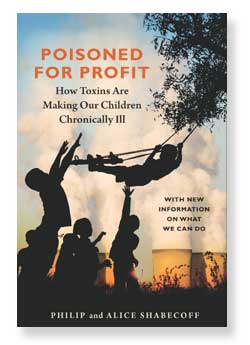A baby innocently enters the world unaware that it has been the victim of a quiet assault from toxins since conception. Exposed in vitro as a result of its mother’s contact with polluted water and clothing, as well as cleaning and healthcare products, an infant is then subjected to more chemicals contained in its mother’s breast milk. In the US, a child has a one-in-three chance of developing a chronic childhood disease, such as birth defects, cancer or neurological problems.
A baby innocently enters the world unaware that it has been the victim of a quiet assault from toxins since conception. Exposed in vitro as a result of its mother’s contact with polluted water and clothing, as well as cleaning and healthcare products, an infant is then subjected to more chemicals contained in its mother’s breast milk. In the US, a child has a one-in-three chance of developing a chronic childhood disease, such as birth defects, cancer or neurological problems. Since World War II, the inci- dence of childhood disease, along with fertility problems and premature births, termed the new “pediatric morbidity,” has been on a steady incline. It threatens the health of children today and possibly the survival of our species.
In Poisoned for Profit, Philip and Alice Shabecoff present an impeccably researched parallel between the proliferation of environmental toxins and the dramatic increase in chronic childhood disease in the US. Philip clearly relies on his 14-year tenure as The New York Times’ environmental correspondent, while his wife is also an accomplished freelance writer.
Through the voice of a prosecutor giving evidence to a jury, they present a criminal case of chemical assault on children. The victims’ stories are woven through the book, as is the complex web of chemical corporations, government agencies, politicians, scientists, lawyers and lobbyists that are perpetrators and co-conspirators in this heinous crime. The book asks: Where is the justice for the children?
The Shabecoffs’ indictment highlights the true cost of pollution, yet a company is “profitable to the extent it can make other people pay the bills for its impact on society.” And the defendant’s profits are substantial. When Rachel Carson wrote Silent Spring in 1962, the chemical industry was worth $2-billion per year. Now, the $689-billion behemoth produces an estimated 12 billion tonnes of chemicals annually.
Poisoned for Profit presents incriminating evidence of the revolving door between industry and government, where lobbyists influence and even craft regulations. The story’s darkest side is exposed in cases where companies hid evidence of illegal toxic dumping and high employee mortality.
Since its inception in the 1970s, the environmental regulatory framework in the US has been systematically deregulated and chronically underfunded, resulting in a situation where chemicals are “innocent until proven guilty.” There are no current limits on the most concerning toxins such as trichloroethylene, bisphenol-A (BPA) and phthalates. And even when regulations exist, enforcement is inadequate – hence, the burden of proof rests on the victims. Cases of contaminated groundwater and toxic playgrounds are uncovered by regular people asking simple questions, such as: Is it normal to have so many cases of childhood leukemia?
The case reveals how corporate lawyers and lobbyists create reasonable doubt by discrediting scientists who have incriminating evidence. In fact, most cases settle out of court with million-dollar fines that are a mere slap on the wrist to chemical companies. Victims are essentially “blackmailed” into silence. The book argues that corporate structure does not act in the best interests of our children, let alone the environment.
For the first time in modern history, our children may not outlive their parents. Fertility issues are on the rise as even young couples struggle to conceive and have full-term pregnancies. With such a bleak outlook, where do we go from here? The book argues that we must first understand the problem and then approach it with solutions. One option is “green chemistry,” a science geared at developing safer alternatives to known toxins. Our real hope lies in dedicated scientists, lawyers and activists who are fighting for children’s health.
Canada has made some progress not seen in the US, but Canadian children are not well protected either. With the exception of BPA, a toxic substance that Health Canada has proposed be eliminated from baby bottles and limited in infant-formula packaging, Canadian children face the same environmental threats as their American counterparts, according to the David Suzuki Foundation. This organization published “the dirty dozen,” a list of chemicals that pervade our personal-care products. Our ability to regulate these chemicals is also inadequate. Canada mimics the US in that “The profits are privatized, while the cost is socialized.”
The Shabecoffs place responsibility not just on chemical companies and government, but on all of us. They question our values in a world where children’s health is secondary. If we are motivated to take action only when it is our own sick child, we remain passive accomplices to the crime. And inevitably, we will face the consequences of the verdict.
Poisoned for Profit: How Toxins Are Making Our Children Chronically Ill, Philip and Alice Shabecoff, White River Jct., Vermont: Chelsea Green Publishing, 2010, 368 pages
This review originally appeared in Just Food, Issue 37.2. Subscribe now to get more book reviews in your mailbox!
Reviewer Information
Stephanie Grylls is the president of Nutrition Naturally, where she helps people understand the connection between food,health and the environment.













